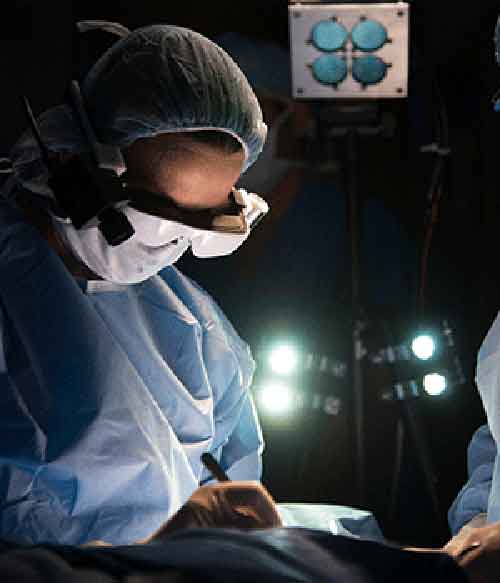
|
High-tech glasses developed at Washington University School of Medicine in St. Louis may help surgeons visualize cancer cells, which glow blue when viewed through the eyewear. The wearable technology, so new it's yet unnamed, was used during surgery for the first time today at Alvin J. Siteman Cancer Center at Barnes-Jewish Hospital and Washington University School of Medicine. Cancer cells are notoriously difficult to see, even under high-powered magnification. The glasses are designed to make it easier for surgeons to distinguish cancer cells from healthy cells, helping to ensure that no stray tumor cells are left behind during surgery. "We're in the early stages of this technology, and more development and testing will be done, but we're certainly encouraged by the potential benefits to patients," said breast surgeon Julie Margenthaler, MD, an associate professor of surgery at Washington University, who performed today's operation. "Imagine what it would mean if these glasses eliminated the need for follow-up surgery and the associated pain, inconvenience and anxiety." Current standard of care requires surgeons to remove the tumor and some neighboring tissue that may or may not include cancer cells. The samples are sent to a pathology lab and viewed under a microscope. If cancer cells are found in neighboring tissue, a second surgery often is recommended to remove additional tissue that also is checked for the presence of cancer. The glasses could reduce the need for additional surgical procedures and subsequent stress on patients, as well as time and expense. Margenthaler said about 20 to 25 percent of breast cancer patients who have lumps removed require a second surgery because current technology doesn't adequately show the extent of the disease during the first operation. "Our hope is that this new technology will reduce or ideally eliminate the need for a second surgery," she said. The technology, developed by a team led by Samuel Achilefu, PhD, professor of radiology and biomedical engineering at Washington University, incorporates custom video technology, a head-mounted display and a targeted molecular agent that attaches to cancer cells, making them glow when viewed with the glasses. In a study published in the Journal of Biomedical Optics, researchers noted that tumors as small as 1 mm in diameter (the thickness of about 10 sheets of paper) could be detected. Ryan Fields, MD, a Washington University assistant professor of surgery and Siteman surgeon, plans to wear the glasses later this month when he operates to remove a melanoma from a patient. He said he welcomes the new technology, which theoretically could be used to visualize any type of cancer. "A limitation of surgery is that it's not always clear to the naked eye the distinction between normal tissue and cancerous tissue," Fields said. "With the glasses developed by Dr. Achilefu, we can better identify the tissue that must be removed." In pilot studies conducted on lab mice, the researchers utilized indocyanine green, a commonly used contrast agent approved by the Food and Drug Administration. When the agent is injected into the tumor, the cancerous cells glow when viewed with the glasses and a special light. Achilefu, who also is co-leader of the Oncologic Imaging Program at Siteman Cancer Center and professor of biochemistry and molecular biophysics, is seeking FDA approval for a different molecular agent he's helping to develop for use with the glasses. This agent specifically targets and stays longer in cancer cells. "This technology has great potential for patients and health-care professionals," Achilefu said. "Our goal is to make sure no cancer is left behind." Dr. Achilefu has worked with Washington University's Office of Technology Management and has a patent pending for the technology. The research is funded by the National Cancer Institute (R01CA171651) at the National Institutes of Health (NIH).
|
透过一副特制的高科技眼镜,医生小心切除闪着蓝光的癌变组织……当地时间2月10日,一台特殊的外科手术在美国密苏里州圣路易斯市一家医院里进行,借助这项刚刚问世的可视技术,原本几不可见的癌细胞变得无所遁形。 据美国媒体报道,这副能够“看见”癌细胞的眼镜由华盛顿大学(W U)放射学和生物医学工程学教授塞缪尔•阿基里弗教授领队研发成功,在理想状态下,它可以帮助外科医生在手术时一次性彻底切除所有癌变组织。 众所周知,即使置于高性能的显微镜下,癌细胞也难以被发现。但有了这副眼镜之后,医生能够轻松区分健康细胞和癌细胞,从而确保首次手术时不会遗漏任何癌变组织,进行二次切除手术以“查缺补漏”的可能性也由此大大降低。 据介绍,使用时,需要先把一种特定的分子药剂涂抹在肿瘤及其周边组织上,这种药剂会附着于癌细胞、令其发出肉眼不可见的光芒,然后,主刀医生戴上一个形似眼镜的头盔式显示器,通过自定义视频技术,即可看清癌细胞分布于何处。 “目前,我们尚处于研究初期,未来会进行更多的改进和测试工作。”乳腺外科医生朱莉•马格塔勒是10日进行手术的主刀大夫,同时也是第一个在实际操作中使用癌细胞可视眼镜的人,“一想到这项新技术将令病患获益良多,我们就干劲十足。” 依据现在的医护流程,外科医生手术时需要切除肿瘤及其附近组织,而这些组织中可能存在、也可能不存在癌细胞。随后,切除下的组织标本被送往病理实验室接受检验,如果在其中发现癌细胞,则需进行第二次甚至多次手术,直至癌变组织被完全切除。 据马格塔勒介绍,依靠现有的技术,无法准备判定癌变组织的全部范围,所以大约20%至25%的乳腺癌患者接受首次手术切除肿瘤后,还需经受第二次手术。 “借助这种癌细胞可视眼镜,可以在首次手术时一次性切除所有癌变组织。这意味着,没有必要再进行后续手术,病人也无需承担随之而来的病痛和手术费用。”马格塔勒希望,这项新技术能够降低、甚至完全消除二次手术。 相关阅读 (信莲 编辑:玉洁)
|
|
|
